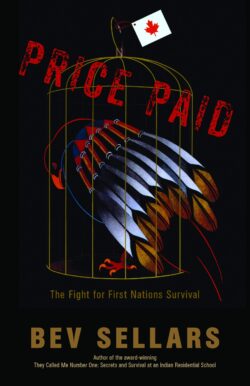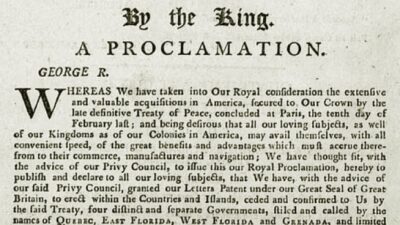#38 Fact, myth, and powerpoint
Paid Price: The Fight for First Nations Survival
By Bev Sellars
Vancouver: Talonbooks, 2016
$19.95 9780889229723
Reviewed by Eldon Yellowhorn
First published November 7, 2016
*
Editor’s note: as happens occasionally at The Ormsby Review, a happy mixup occurs and we end up with two reviews of the same book. For our second review of Bev Sellars’ Paid Price: The Fight for First Nations Survival, see the review here by Caroline Woodward. — Richard Mackie
*
 Recycling is a common theme running through this book. Just like the 100% post-consumer recycled paper and the cover design, much of the historical rhetoric is reclaimed and reused.
Recycling is a common theme running through this book. Just like the 100% post-consumer recycled paper and the cover design, much of the historical rhetoric is reclaimed and reused.
In the preface, Bev Sellars explains that her motivation for this contribution stems from her experience as legal counsel in the British Columbia Treaty Commission.
What put the burr in her craw was the ahistorical, tunnel vision of mainstream Canada. Federal and provincial treaty negotiators knew the law and public policy, but in their modern bias there no was no room for the precise provenance of history.
Sellars’ remedy to this tendency to privileged, self-serving presentism was to compose a series of powerpoint presentations to give some details about the Aboriginal peoples’ side of the historical ledger, which she then presented at workshops.
However, largely for this reason the book never aspires to be more than, and never rises beyond, an overly long powerpoint presentation.
Beyond the well-travelled path through historical trivia that attests to an imagined golden, olden Indigenous Age, Sellars asserts that people have been in the Americas for 40,000 years. Where and how she dug up that number she does not explain.

In due course, newcomers arrive to disrupt the pre-contact era. In swift succession, Sellars breezes past the milestones of dispossession, e.g. the doctrine of discovery and the Royal Proclamation of 1763, that continue to resonate with meaning among Aboriginal people.
However, some of the historical information she presents is speculation disguised as fact. For example, palaeodemography in the Americas is fraught with ambiguity and any number generated by it is just that—a number. So her contention that 67.5–106.4 million casualties resulted from European contact is sensationalism for its own sake.
That colonization always inspires a good rant holds true here. Much of Chapter 3 is a narrative of hardship imposed by a colonial authority and enforced by Christian missionaries. Oddly, it competes here with fond memories of a bucolic life on a small reserve with a tight-knit family coupled with a nostalgic community history.


Of course, no volume on First Nation survival would be complete without a diatribe on the Indian Act, so Sellars devotes the next three chapters to this instrument of oppression both as a legal artefact and as “the devil you know.”
While amendments to the Indian Act create abstract policies, they also have real impacts on communities, families, and individuals. However, the disjointed discussion never achieves its intended purpose.
One example that illustrates this point is Sellars’ interpretation of the Drybones decision of 1969 (p. 96). She ignores some essential elements of this case and maintains that it hinged on whether or not there are Indian Reserves in the Northwest Territories.
Nowhere does she mention that the section of the Indian Act banning Indians from possessing alcohol, under which Joseph Drybones was charged, had a harsher sanction than if he had been charged under the Northwest Territories Liquor Ordinance.

This case offended the guarantee of equality before the law expressed in the Canadian Bill of Rights of 1960 because two conflicting statutes imperilled one man. Perhaps the lesson to be learned here is that regular attendance at lectures in law school is the best preparation for a law career.
Bill Wilson, the author’s husband, closes Chapter 6 with a first person account of his connection to Leonard Peltier, the long-time political activist and icon of the American Indian Movement.
Wilson’s voice persists into Chapter 7. His memoir relates to the era when Canada patriated its constitution. His first hand observations as a player in the national conferences on aboriginal affairs are the most interesting part of the book and really should form the basis of a stand-alone volume.
Chapters 8 through 10 restore the author’s voice. Not burdened by extensive research, this retrospection meanders through impressionistic explanations rather than shoring up insights based on detailed analysis of textual records.
Writing history requires discipline in order to detach outrage from the finding of facts, which are often expressed in the loose vernacular of the times.

Certainly there is a lot to take umbrage about in archival documents that invariably regard Aboriginal people as the marginalized subaltern. To assume otherwise or to apply modern mores to historical texts will only reinforce a durable indignation. Studying history is about gaining insights into the big picture of the world out there and situating local experience therein. Nothing like that emerges from these pages of recycled paper. Indeed, much of the discussion here is bereft of context or citation, which gives the impression that its purpose is to implicate history as just another means of oppression.
Anyone looking for fresh historical synthesis or novel insights will therefore be disappointed, but then who seeks deep meaning in powerpoint presentations or informational workshops?
One take-away message is Sellars’ point that, on the eve of this sesquicentennial, Aboriginal people still consider themselves Canadian if necessary, but not necessarily Canadian.
*

Dr. Eldon Yellowhorn (Otahkotskina) is from the Piikani First Nation. Growing up on a farm in a rural community brought many opportunities to explore the Oldman River valley and the Porcupine Hills. His early adventures there had a big influence on his decision to pursue a career in palaeontology and archaeology. He received degrees in geography (BSc ‘83) and archaeology (BA ‘86) at the University of Calgary. He was awarded a Community Scholar Fellowship by the Smithsonian Institution in 1988 and worked with the curator for North American archaeology in Colorado. He began graduate school at Simon Fraser University, where he studied archaeology (MA ‘93). He completed his student career at McGill University (PhD ‘02). He was a member of the design committee that produced the exhibit for the Hall of the First Peoples at the Canadian Museum of Civilization (now the Canadian Museum of History) between 1992 and 2002, when the exhibit opened. He was appointed to faculty at Simon Fraser University in 2002 where he teaches archaeology and First Nations studies. He was instrumental in establishing the Department of First Nations Studies in 2012 and was its first chair. He is a long-time member of the Canadian Archaeological Association and served on its executive committee as President (2010–12). His research program brings him back to the Piikani First Nation each summer where he continues to chronicle the historical and contemporary manifestations of Piikani culture.
*
The Ormsby Review. More Books. More Reviews. More Often.
Publisher and Editor: Richard Mackie
The Ormsby Review is a journal service for in-depth coverage of B.C. books and authors. The Advisory Board consists of Jean Barman, Wade Davis, Robin Fisher, Cole Harris, Hugh Johnston, Patricia Roy, David Stouck, Maria Tippett, and Graeme Wynn. Scholarly Patron: SFU Graduate Liberal Studies. Honorary Patron: Yosef Wosk. Provincial Government Patron since September 2018: Creative BC
“Only connect.” – E.M. Forster
2 comments on “#38 Fact, myth, and powerpoint”
Comments are closed.